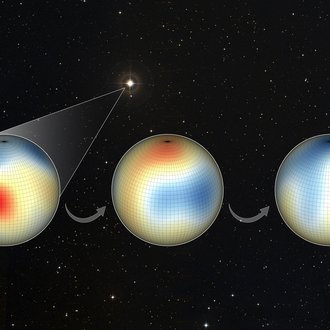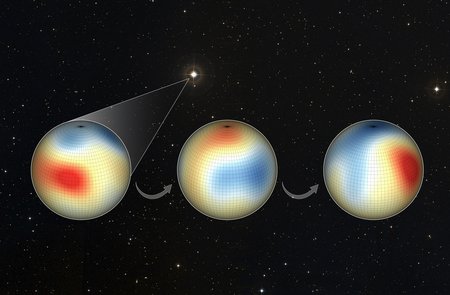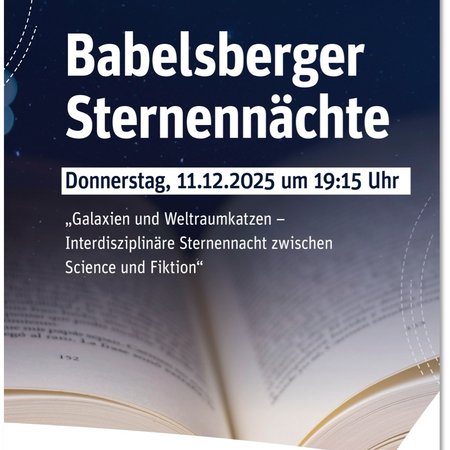A look into the heartbeat of a star

The varying magnetic field of the star Iota Horologii at three different times showing a double polarity reversal (magnetic cycle). The radial component of the magnetic field is shown, with the colour indicating the strength and polarity of the field (red = positive, blue = negative). On average, the magnetic cycle of the star is completed every 2.1 years.
Credit: AIP/J. Alvarado-Gómez, background: DSS colored - Digitized Sky Survey - STScI/NASA, Colored & Healpixed by CDS, extracted with Aladin Lite.Scientists at the Leibniz Institute for Astrophysics Potsdam (AIP) have uncovered the intricate magnetic heartbeat of a distant star remarkably similar to our own Sun—but much younger and more active. This groundbreaking study, part of the Far Beyond the Sun campaign, follows nearly three years of ultra precise observations and sheds new light on how stars like our Sun generate their magnetic fields—and how these fields evolve over time.
The star at the heart of this research is Iota Horologii (nicknamed “ι Hor”, in the constellation Horologium, the pendulum clock at the southern sky), located roughly 56 light years from Earth. At about 600 million years old—far younger than our 4.6 billion year old Sun—ι Hor spins faster and displays far more vigorous magnetic activity than the Sun. By pointing the HARPS polarimeter on the European Southern Observatory’s 3.6 m telescope at La Silla Observatory in Chile toward this star, AIP researchers collected 199 nights of spectropolarimetric data over six observing seasons.
Using an advanced technique known as Zeeman Doppler Imaging (ZDI), the team transformed these measurements into 18 distinct “maps” of ι Hor’s large scale magnetic field, spread over roughly 140 full rotations of the star. These maps chart how magnetic features appear, vanish, and even flip polarity—phenomena that trace the deep seated dynamo processes within the star’s turbulent interior.
One of the most remarkable findings is that ι Hor completes a full magnetic cycle—equivalent to the Sun’s 22 year cycle—in just above 2 years (about 773 days). Over this period, the star’s magnetic north and south poles reverse, only to switch back again, creating a rhythmic magnetic heartbeat far faster than our Sun.
Perhaps even more exciting is the creation of the first “magnetic butterfly diagrams” for a star beyond our own. On the Sun, these diagrams track the latitudinal migration of sunspots and magnetic field as the cycle progresses: spots emerge at mid latitudes and steadily drift toward the equator. By averaging the mapped magnetic field strength at different latitudes for each epoch, AIP scientists produced analogous diagrams for ι Hor—revealing how its magnetic regions migrate poleward and equatorward over each cycle.
From these stellar butterfly diagrams, the team extracted direct estimates of large scale flows on ι Hor’s surface. They found that radial field regions migrated toward the polar regions at speeds of 15–78 m/s (comparable to a high-speed train), while the toroidal field drift toward the equator proceeds at 9–19 m/s (average car speeds), both substantially faster than the corresponding solar flows. This marks the first measurement of such meridional (poleward) and equatorward flows on any star besides the Sun.
“These results offer a critical benchmark for understanding magnetic dynamos—the engines that drive stellar and solar activity,” says Dr. Julian Alvarado Gómez, lead investigator at AIP. “By comparing ι Hor’s rapid magnetic cycle and strong activity to the Sun’s more leisurely 22 year rhythm, we gain deeper insight into how factors like rotation rate and age influence magnetic evolution.” Furthermore, magnetic activity governs stellar winds, flares, and high energy radiation—all of which can shape the environments of orbiting planets. Insights from ι Hor, which hosts at least one known exoplanet, help astronomers assess how young Sun-like stars might influence the habitability of worlds in their system. The full results appeared in the article “Far beyond the Sun III: The Magnetic Cycle of ι Horologii” in the journal Astronomy & Astrophysics.
Images
The varying magnetic field of the star Iota Horologii at three different times showing a double polarity reversal (magnetic cycle). The radial component of the magnetic field is shown, with the colour indicating the strength and polarity of the field (red = positive, blue = negative). On average, the magnetic cycle of the star is completed every 2.1 years.
Big screen size [1000 x 656, 100 KB]
Original size [3806 x 2500, 1.2 MB]



